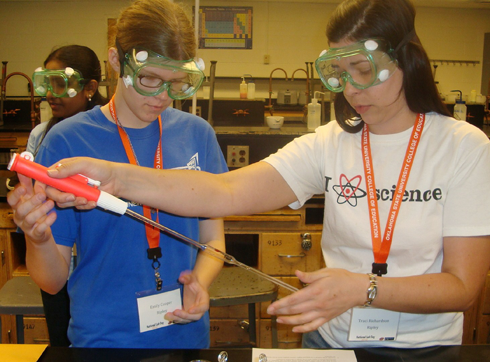A center for STEM research
Tuesday, April 3, 2012
Oklahoma State University is poised to become a leader in the key educational areas of STEM (science, technology, engineering and mathematics).
CRSTL (the Center for Research on STEM Teaching and Learning), which recently has been established in the College of Education, aspires to leadership in providing opportunities for university faculty, pre-service teachers, in-service teachers, school administrators, informal educators and community leaders to improve PK-20 student learning, teacher preparation and teacher professional development in science and mathematics.
The center uniquely focuses on transformative research that can help address challenges in science, mathematics, engineering and innovation. CRSTL will engage in a range of collaborative projects which promise extraordinary outcomes, such as revolutionizing the STEM teacher education continuum or disrupting accepted theories, procedures and perspectives.
Developing a Concept
Dr. Julie Thomas, the Frank and Carol Morsani Endowed Chair in Science Education, spearheaded planning efforts to establish CRSTL and serves as its director. CRSTL’s official launch marked a major step for Thomas, who began dreaming about and planning for a STEM education center when she arrived at OSU in 2007.
“Science teachers meet at their own conferences and read their own journals. The same is true for math teachers and researchers. In order for there to be collaboration, there needed to be some infrastructure or vehicle or resource to enable it,” Thomas said.
Thomas worked with other faculty and the administration in the College of Education and across campus to develop a proposal for CRSTL. In the spring of 2011, that proposal was presented to the OSU Dean’s Council. The proposal was met with great enthusiasm. The deans recognized that CRSTL had the potential to position OSU as a leader. There are many STEM centers across the country, but Oklahoma State’s focus on teaching and learning research sets it apart.
“That focus is partly generated by who we are as a College of Education and partly by my interest,” Thomas says. “That interest, on how to improve STEM Education PK-20, is what makes us unique nationwide.
“At OSU, we have a willingness of faculty to collaborate. We don’t have people who only want to work in their lab or only with others in their field. People are friendly and open to the idea of collaborative effort. That makes this a wonderful place to work and it makes for endless possibilities with the center.”
The Center’s Work
CRSTL serves as a hub for STEM educators at OSU, encouraging and promoting research. Faculty from the College of Education, from areas such as physics, chemistry, geology and mathematics in the College of Arts and Sciences, from the College of Engineering, Architecture and Technology and the College of Agriculture and Natural Resources are invested in the center as they work on STEM-related research projects.
“In the time I’ve been dreaming about the center, I have assembled a variety of partners and income sources that have helped to fund small projects. They were STEM education research projects and because we now have a center, they have a home within in the center,” Thomas explains.
Projects are focused on finding out more about learners and identifying ways to improve instruction.
One project provided a research experience in environmental engineering or biotechnology for middle school science and math teachers and undergraduate engineering students. The teachers developed curricula that translated their research into engaging experiments that could be used in their classrooms.
Another project addressed the lack of geosciences taught at the high school level by giving high school teachers the opportunity to participate in authentic geoscience activities that could be easily integrated into biology, chemistry or physics lessons.
Faculty from Education and Arts and Sciences have worked together to participate in National Lab Day on the OSU campus the last two years. The event is part of a nationwide initiative to bring discovery-based science experiences to K-12 student groups and expose them to real scientists, lab experiences and future job choices.
Thomas is also working on a project to develop dissemination materials for teachers, parents and children in rural, low socioeconomic and largely American Indian populations in Oklahoma. Her research has shown that there is little opportunity for children from remote areas to know about STEM careers.
All of CRSTL’s projects will be showcased online in an effort to connect researchers and display each project as part of a university-wide initiative.
Potential to Impact
Consistent with Oklahoma State’s land-grant mission, CRSTL projects aim to improve teaching and learning in STEM education in Oklahoma and the nation.
The Center will focus on research related to problems and challenges in STEM education, including the STEM career pipeline.
Results, then, will be disseminated to the appropriate audiences such as guidance counselors and STEM educators through professional meetings, publications, and workshops.
“We want to make sure that students not only know about STEM careers, but are prepared for those careers in the best way possible through education,” Thomas said.
CRSTL is headquartered on the third floor of Willard Hall. By design, the center does not have its own budget. All projects are externally funded and the center does not take percentages of grants.
Thomas is confident that CRSTL will continue to develop and grow.
“As the center becomes public knowledge, I think additional faculty will present themselves and propose ideas. We want to let the center grow in ways that make sense to the people who work at OSU and for it to become what the faculty here want.
“I’m excited about the potential for research initiatives to be born and develop. I’m hoping the center will allow conversations and connections that might not happen otherwise. It could have a huge impact on the way students are educated at OSU and in K-12 schools.”
For more information about CRSTL, visit the website at http://education.okstate.edu/centers-a-clinics/crstl or contact Dr. Julie Thomas at julie.thomas@okstate.edu or 405-744-3840.
